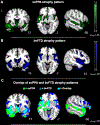Enhanced positive emotional reactivity in frontotemporal dementia reflects left-lateralized atrophy in the temporal and frontal lobes
- PMID: 35930892
- PMCID: PMC9867572
- DOI: 10.1016/j.cortex.2022.02.018
Enhanced positive emotional reactivity in frontotemporal dementia reflects left-lateralized atrophy in the temporal and frontal lobes
Abstract
In frontotemporal dementia (FTD), left-lateralized atrophy patterns have been associated with elevations in certain positive emotions. Here, we investigated whether positive emotional reactivity was enhanced in semantic variant primary progressive aphasia (svPPA), an FTD syndrome that targets the left anterior temporal lobe. Sixty-one participants (16 people with svPPA, 24 people with behavioral variant FTD, and 21 healthy controls) viewed six 90-sec trials that were comprised of a series of photographs; each trial was designed to elicit a specific positive emotion, negative emotion, or no emotion. Participants rated their positive emotional experience after each trial, and their smiling behavior was coded with the Facial Action Coding System. Results indicated that positive emotional experience and smiling were elevated in svPPA in response to numerous affective and non-affective stimuli. Voxel-based morphometry analyses revealed that greater positive emotional experience and greater smiling in the patients were both associated with smaller gray matter volume in the left superior temporal gyrus (pFWE < .05), among other left-lateralized frontotemporal regions. Whereas enhanced positive emotional experience related to atrophy in middle superior temporal gyrus and structures that promote cognitive control and emotion regulation, heightened smiling related to atrophy in posterior superior temporal gyrus and structures that support motor control. Our results suggest positive emotional reactivity is elevated in svPPA and offer new evidence that atrophy in left-lateralized emotion-relevant systems relates to enhanced positive emotions in FTD.
Keywords: Elation; Euphoria; Mood; Neurodegeneration; Semantic dementia.
Copyright © 2022 The Authors. Published by Elsevier Ltd.. All rights reserved.
Conflict of interest statement
Declaration of competing interest The authors report no competing interests.
Figures





References
-
- Agosta F, Galantucci S, Canu E, Cappa SF, Magnani G, Franceschi M, Falini A, Comi G, & Filippi M (2013). Disruption of structural connectivity along the dorsal and ventral language pathways in patients with nonfluent and semantic variant primary progressive aphasia: A DT MRI study and a literature review. Brain and Language, 127(2), 157–166. 10.1016/j.bandl.2013.06.003 - DOI - PubMed

